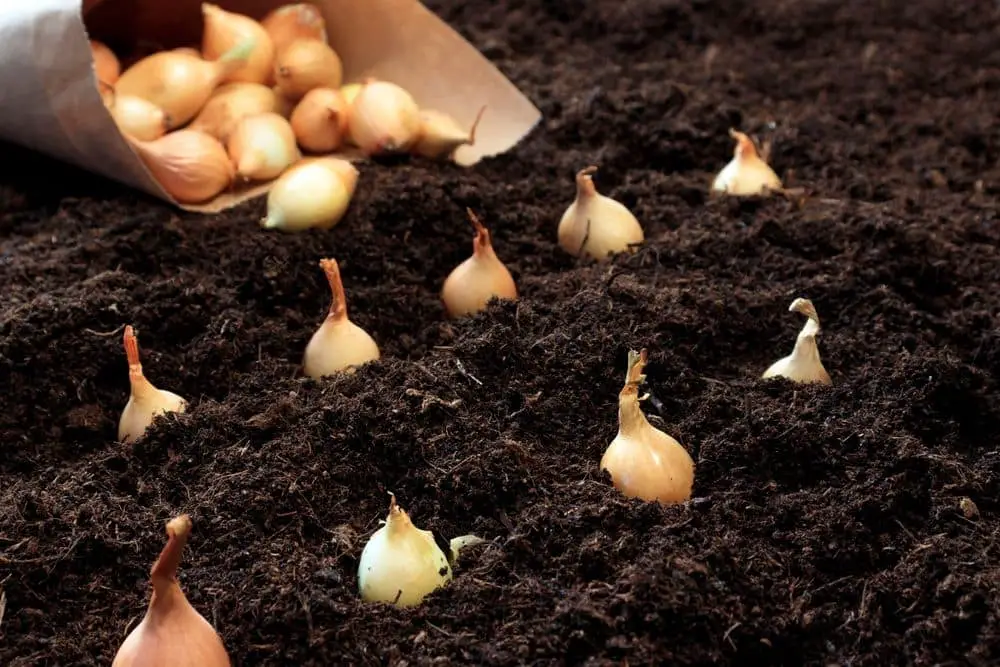The vegetable, onion, can be cultivated in pots or the garden.
Discover the 6 Stages of Onion Growth and Get a Bumper Harvest!
Onion cultivation involves several stages of growth, from germination to harvesting. Understanding each stage can help you grow healthy, high-quality onions that are flavorful and delicious.
6 Onion Growing Stages Are:
- Germination
- Seedling
- Vegetative
- Bulb Formation
- Maturation
- Harvesting Stage
Stage 1: Germination
The germination process involves the growth and development of a seed into a new plant. It starts when the seed absorbs water and begins to sprout, sending out a root and a shoot.
During germination, the onion seed’s embryo begins to consume the seed’s outer layer as it grows.
The root system will grow down into the soil, while the shoot system will grow upward toward the surface.
As the shoot system reaches the surface, it will initiate the process of photosynthesis, which is the process by which plants produce food using light energy from the sun.
This is important for the plant’s growth and development.
The germination stage is critical for the success of the onion plant, as it determines whether the seed will successfully grow into a healthy plant.
Factors that can affect the germination process include temperature, humidity, and soil type.
To help ensure successful germination, it is vital to plant the seeds in well-draining soil rich in organic matter and to provide the seeds with the right amount of moisture.
It is also essential to keep the soil temperature within the ideal range for onion seed germination, typically between 50 and 85 degrees Fahrenheit.
Stage 2: Seedling
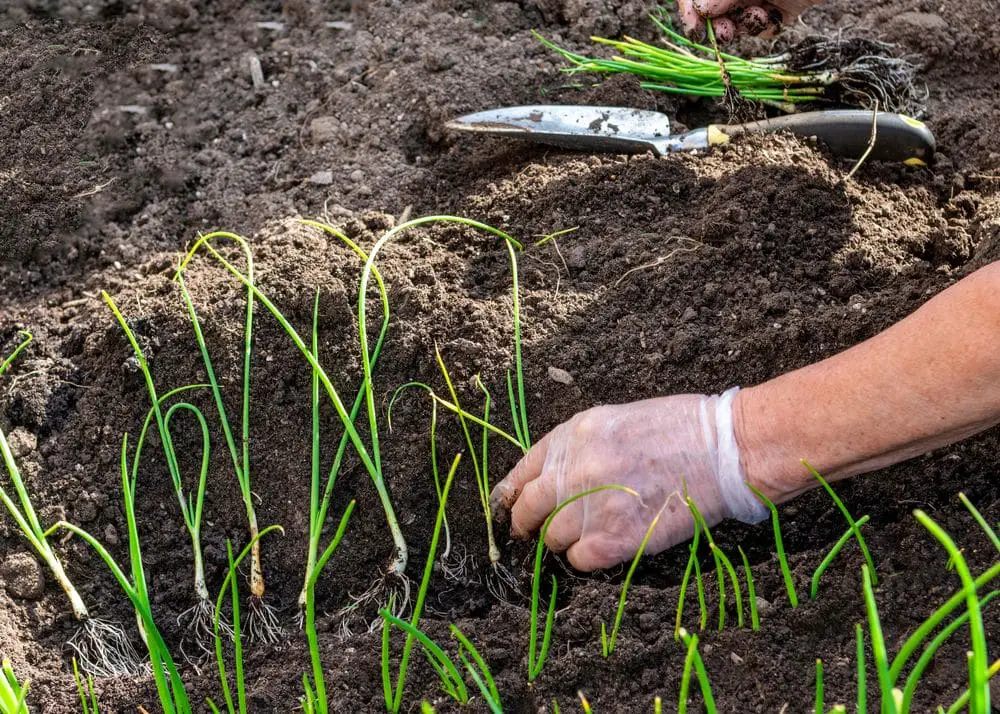
During the seedling stage, the onion plant will continue to grow and develop, sending out new leaves and roots.
The plant is still relatively small and delicate at this stage, so it is vital to take care of it by providing it with the right amount of water and nutrients.
As the seedling grows, it will become more resilient and able to withstand some stress.
However, it is still essential to protect it from extreme weather conditions, such as extreme heat or cold, and pests and diseases.
One way to ensure that seedlings receive enough water and nutrients is to plant them in well-draining soil rich in organic matter.
It is also important to water the seedlings regularly and fertilize them as needed, using a balanced fertilizer that is appropriate for onion plants.
As the seedlings grow, they will eventually develop true leaves, which are leaves that resemble the shape of a mature plant.
This is a sign that the seedlings are well-established in the soil and ready to move on to the next growth stage, the bulbing stage.
It is a good idea to thin out the seedlings, if necessary, during the seedling stage, leaving only the strongest and healthiest plants to grow.
This will help ensure that the onion plants have enough space and resources to grow to their full potential.
Did you know: https://www.frontiersin.org/articles/10.3389/fnut.2021.669805/full stated in a study that “Accumulated studies have revealed that onion and its bioactive compounds possess various health functions, such as antioxidant, antimicrobial, anti-inflammatory, anti-obesity, anti-diabetic, anticancer, cardiovascular protective, neuroprotective, hepatorenal protective, respiratory protective, digestive system protective, reproductive protective, and immunomodulatory properties”.
Stage 3: Vegetative Stage
During the vegetative stage, the onion plants will continue to grow and develop, putting out new leaves and roots.
This stage is characterized by rapid growth and development as the plants establish their fundamental framework and prepare for the next growth stage.
During this stage, it is crucial to provide the onion plants with plenty of water and nutrients to support their growth.
This may include watering the plants regularly and fertilizing them as needed using a balanced fertilizer.
A lack of water or nutrients can hinder the plants’ growth and lead to smaller bulbs and lower yields.
In addition to water and nutrients, onion plants also require plenty of sunlight to thrive during the vegetative stage.
Onions are generally considered full-sun plants, meaning they need at least six hours of direct sunlight per day to grow well.
It is also essential to give the onion plants enough space to grow during the vegetative stage.
Crowding the plants too close together can lead to stunted growth and smaller bulbs.
It is generally recommended to leave at least 4-6 inches of space between each onion plant to allow them room to grow.
The length of time an onion plant spends in the vegetative stage can vary depending on the variety of onions and the growing conditions.
Some onion plants may reach full maturity within a few weeks, while others may take several months.
It is essential to monitor the plants closely and provide them with the proper care and conditions to support their growth.
Are you looking for Onion Recipes? Look no Further – BBC Good Food has many great recipes!
Stage 4: Bulb Formation Stage
During the bulb formation stage, the onion plant’s stem will start to develop into a miniature bulb just below the soil’s surface.
This bulb will continue to grow and mature until it is ready to be harvested.
At this stage, the onion plant may also start to produce additional bulbs, either as single large bulbs or as a cluster of smaller bulbs.
The type of onion plant and the growing conditions will influence the size and number of bulbs produced.
As the bulbs start to form, it is essential to monitor their progress and provide the plants with the proper care and conditions to support their growth.
This may include watering the plants regularly, fertilizing them as needed, and protecting them from pests and diseases.
When the bulbs are ready to be harvested, it is vital to do so as soon as possible to prevent them from rotting in the ground.
You can store onions for several months after they are harvested, but it is generally best to use them as soon as possible to enjoy their best flavor and quality.
Once the bulbs are harvested, they should be dried and cured before storing them.
This will help preserve their quality and extend their shelf life.
To cure onions, place them in a well-ventilated area with plenty of sunlight and let them dry for several days or until the outer layers of the bulbs are dry and papery.
Then, store them in a cool, dry place, such as a pantry or basement, to keep them fresh for as long as possible.
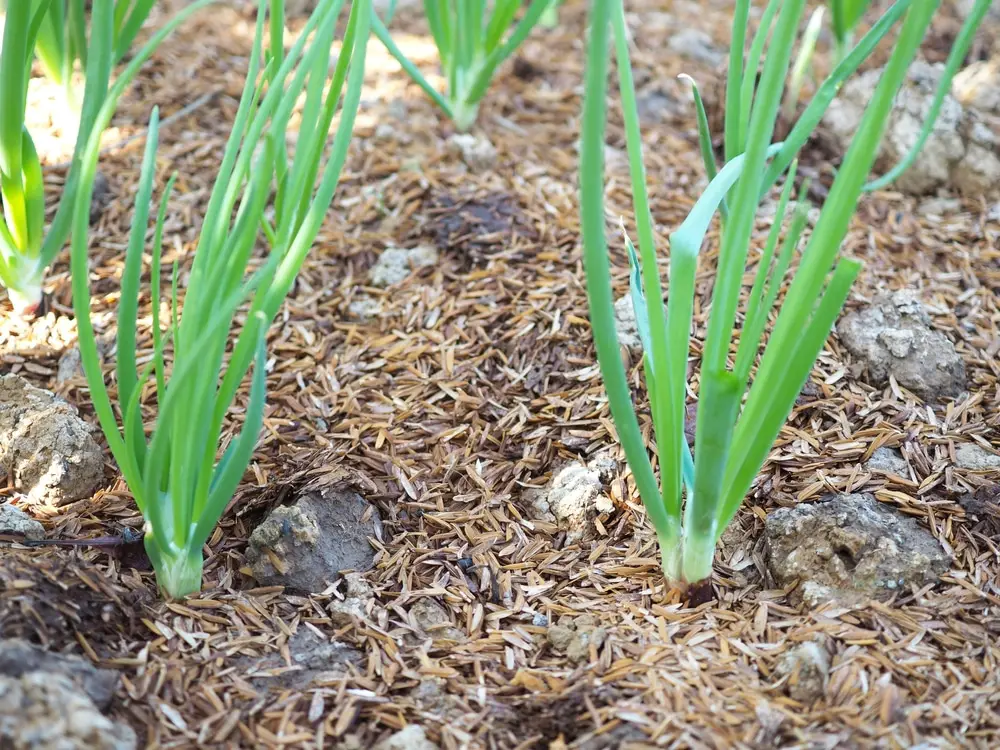
Stage 5: Maturation Stage
During the maturation stage, the onion plant will undergo several changes as it approaches the end of its life cycle.
The leaves will start to wither and turn brown, and the plant may start to produce a flower stalk as it enters its reproductive phase.
As the plant matures, it will focus on storing carbohydrates in the bulb rather than producing new leaves for growth.
This is because the lengthening days of summer signal to the plant that it is time to prepare for the end of its life cycle.
As the maturation stage progresses, the onion tops will start to sag and have a straw-like appearance.
They may also turn a purplish color.
This is a sign that the onion is approaching its peak quality and is ready to be harvested.
To determine when an onion is at its peak quality, you should wait until the neck of the onion has fully formed but is still flexible enough to bend without cracking.
At this point, the onion will have reached its full size and be at its sweetest and most flavorful.
After the onion has matured, it is essential to harvest it as soon as possible to prevent it from rotting in the ground.
Once the onions are harvested, they should be dried and cured to preserve their quality and extend their shelf life.
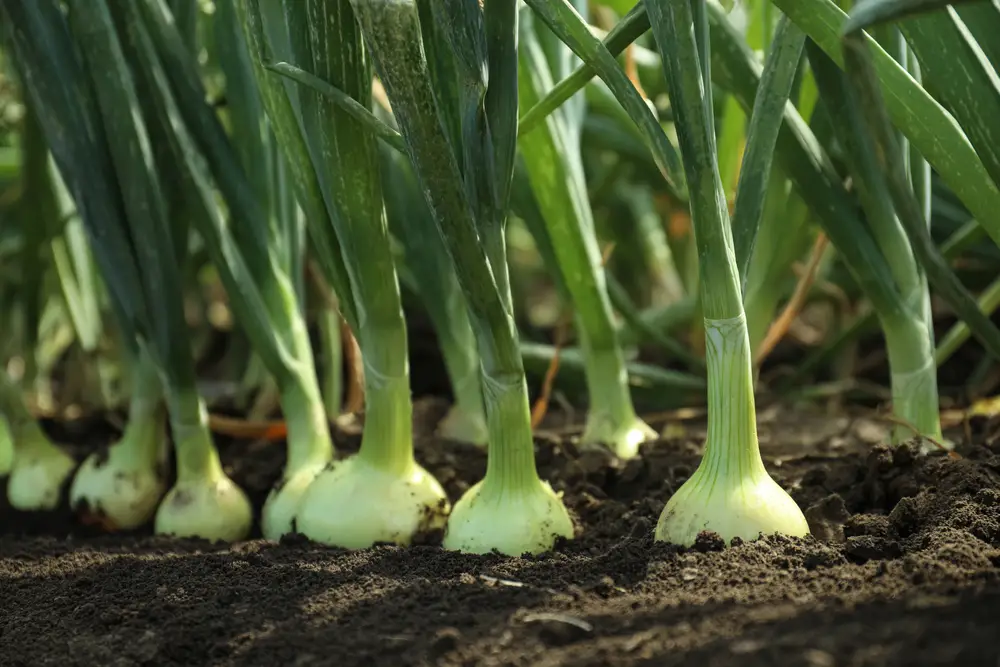
Stage 6: Harvesting Stage
Once the onions mature and are ready to be harvested, it is important to proceed cautiously to avoid damaging the bulbs.
You can use several methods to harvest onions, including a digging fork, shovel, or spade.
To harvest onions with a digging fork, start by loosening the soil around them and gently lifting them out of the ground using the fork.
Alternatively, you can use a shovel or spade to cut the onions off at the ground or dig down and lift them out of the soil.
Whichever method you choose, it is essential to leave a sufficient amount of the stalk attached to the onion after peeling it.
This will help the onion retain its shape and prevent it from losing moisture too quickly.
After the onions are harvested, it is essential to dry and cure them to preserve their quality and extend their shelf life.
To cure onions, place them in a well-ventilated area with plenty of sunlight and let them dry for several days or until the outer layers of the bulbs are dry and papery.
Then, store them in a cool, dry place, such as a pantry or basement, to keep them fresh for as long as possible.
Once the onions are cured and stored, you can use them in a variety of dishes and recipes.
Onions are versatile ingredients that can be used raw or cooked, adding flavor and depth to a wide range of dishes.
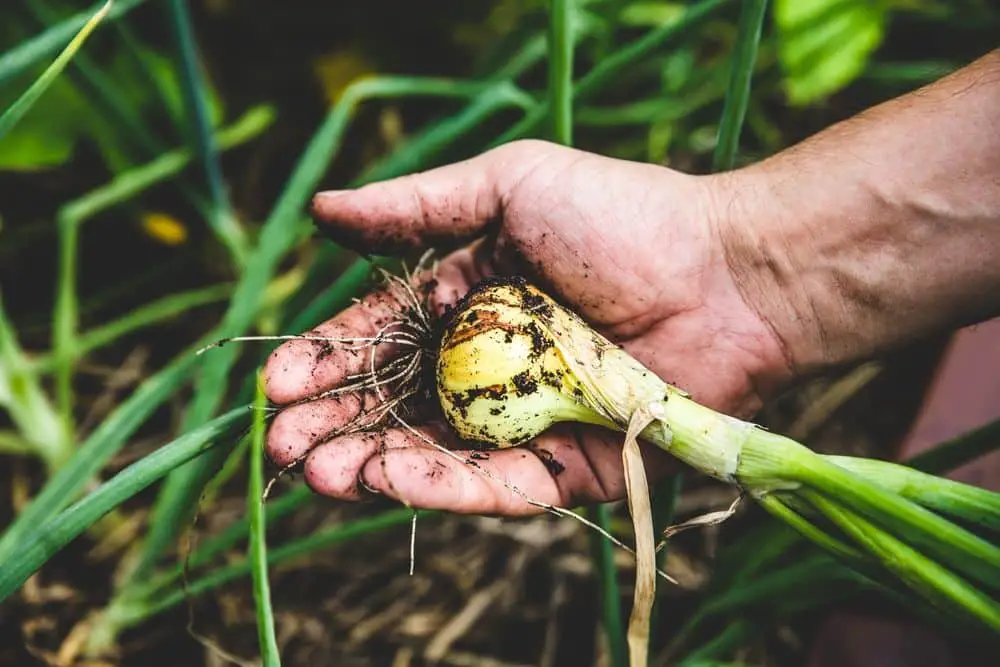
Interested in reading more about: the 7 Growth Stages of a Lemon Tree
The Delicious Wait: How Long It Takes for Onions to Grow Fully
Onions can take anywhere from 3 to 5 months to fully mature, depending on the variety and the growing conditions.
Some varieties of onions may take longer to mature than others. Factors that can affect the growing time of onions include the type of soil, the amount of water and sunlight the plants receive, and the temperature of the growing area.
Onions are typically ready to harvest when their tops have fallen over, and the bulbs have reached their full size.
To determine if an onion is ready to harvest, you can gently lift the plant and check the size of the bulb. If the bulb is large enough and has a dry, papery skin, it is likely ready to be harvested.
Onions are good for you: Healthline stated, “Onions may have several health benefits, mostly due to their high content of antioxidants and sulfur-containing compounds.”
Onion Mania: A Guide to the Many Varieties of this Flavorful Vegetable
There are wide varieties of onions, which can be classified into several categories based on their appearance and use.
Sweet onions: These onions have a high water content and a mild, sweet flavor. Examples include Vidalia onions and Walla Walla onions.
Yellow onions: These are the most common type of onion, and they have a papery skin and a golden-brown color. They have a medium-strong flavor and are versatile in cooking.
White onions: These onions have a papery skin and a white or pale yellow color. They have a milder flavor than yellow onions and are often used in Mexican and Latin American cooking.
Red onions: These onions have reddish-purple skin and a mild, sweet flavor. Due to their color, they are often used in salads and as garnish.
Green onions: Also known as scallions, these onions are picked before the bulb has fully formed. They have long, thin green tops and a mild, slightly sweet flavor.
Shallots: These onions are small and have a thin, papery skin. They have a mild, sweet flavor and are often used in French cooking.
Pearl onions are small onions with white or pale yellow skin. They have a sweet, mild flavor and are often pickled or used in stews.
Leeks are a type of onion grown for its long, white stem and green tops. They have a mild, slightly sweet flavor and are often used in soups and other dishes.
Harvesting Onions: How Many Seasons Can You Expect from a Single Plant?
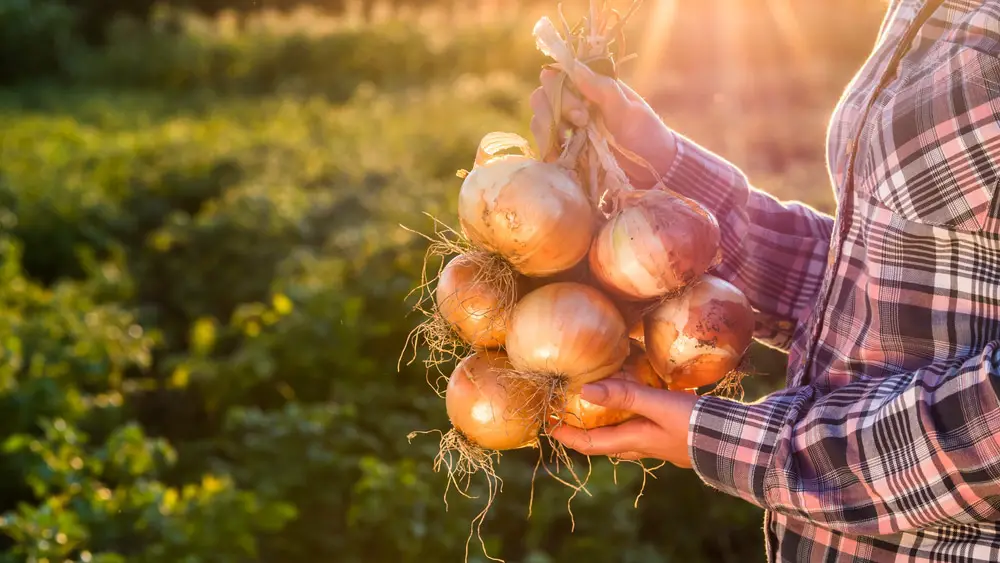
An onion plant can typically be harvested for several seasons.
Onions are biennial plants, which means they have a two-year life cycle.
Onions produce leaves and bulbs in the first year of their life cycle.
The bulbs can be harvested and eaten in the first year, but they are usually smaller and less flavorful than bulbs that have had a chance to mature for a full two years.
In the second year of the life cycle, the onions produce flowers and seeds, after which the plant will die.
However, you can often continue to harvest onions from a single plant for several seasons by only taking a few bulbs at a time and allowing the plant to continue growing.
In conclusion, onion growing involves several stages, including soil preparation and planting seeds or seedlings.
As the plants grow, they go through the six growing stages.
Proper care, including watering, fertilizing, and weed control, is vital during each stage to ensure a successful harvest of healthy onions.
With a bit of attention and patience, you can enjoy homegrown onions in your cooking for months to come.
Happy Gardening!
Read More:
How to Grow and Harvest Bunching Onions
11 Best Companion Plants for Spinach

